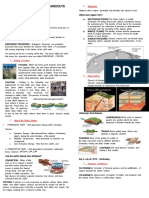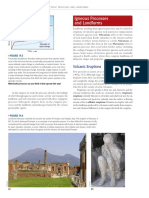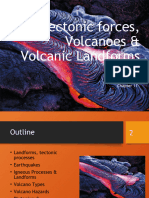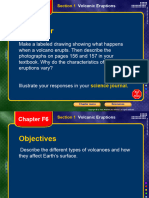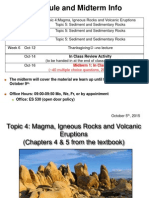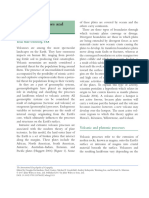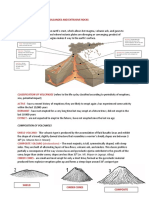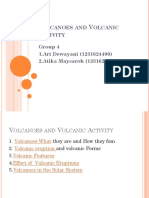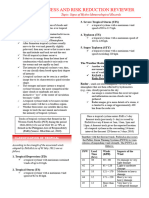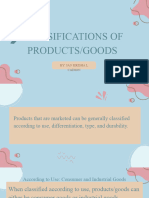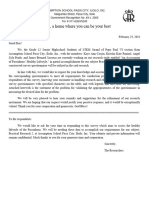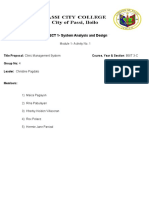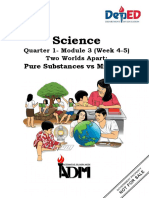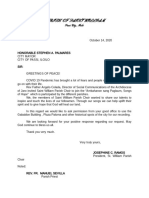0 ratings0% found this document useful (0 votes) 47 views5 pagesEALS Note 4
Copyright
© © All Rights Reserved
We take content rights seriously. If you suspect this is your content,
claim it here.
Available Formats
Download as PDF or read online on Scribd
" ReroTitol oa EN
ae) dodive \ hom yy diver
yy by
Earth's Landforms
are a shaped by
influenced by
tector generate >| tectonic
forces processes
may be
© compressive
© tensional
© shearing
1. Describe where Earth’s internal heat comes from.
2. Cite evidences to support continental drift.
3. Give the distinguishing features of the different plate boundaries.
4, Explain how the seafloor spreads,
5. Describe the evolution of ocean basins.
6
Describe how the rocks behave under diferent types of sess, such as compression, pulling apart,
cand shearing,
7. Describe how magma is formed (magnetism).
8. Devise ways to facilitate own learning.
9. Display scientific values and attitudes.
Chapter 6 Endogenic Processes © 105�Recta don ay)
1s of rock deformation.
Using a diagram, describe the three different ia ress, ond shearing
Differentiate the following: tensional stress, comPr and reverse foult
Using a Venn diagram, compare and contrast normal fault an‘
How is dip-slip fault different from strike-slip faul®
shan! ific plate.
Using a diagram, show normal fault between Philippine plate and Paciie P
PP rw
6.3 Volcanism
Volcanism is one of the endogenic processes: Ie is a phenomenon is
from Earth's interior onto the surface through volcanoes: ;
‘on the crust. The vent is like a chimney; it is where magma,
ter. The large, almost circular
referred to as crat
saldera. Crater lakes sometimes
n which materials are erupted
A voleano is a vent or a series of vents
ash, and gases are released. The mouth of che vent is i
depression formed either by the collapse or explosion of the volcano is
form in these calderas.
Volcanism and Tectonics
Look ae the figure below. Try to infer the relat
you notice that active volcanoes lie along subduction zones?
cionship between volcanic activity and tectonics. Do
Eurasian plate
Eurasian plote
= North-American plate
Son Andreas fault yw! ze
Nvideatonie iran plate
Pacific plate agynnne ridge \Arabicr>"
: Altican plate 368
INdo-Atlantic
ridge
ridge
Antarctic plate Antarctic plate
Figure 6-15. How are volcanic activities related fo the subduction zones?
114. © You and the Natural World—Earth and Life Science�About 70% of Barth's volcanic activity occurs along a circle of subduction zones in the Pacific
Ocean. It is called the"ring of five.”
Another belt of volcanic activity lies near the convergent margin of the African plate, It covers the
area of southern Europe through the Middle Base, Volcanic activity is also detected along the Aus
plate boundary and is concentrated beneath the ocean, Volcanoes locared along the divergent plate
margins include those in the Bast African rife valleys and chose along the m
provinces in Western United States.
ins of the basin and range
Magma and Other Volcanic Materials
As you drill into the crust, the temperature rises 30°C for every kilometer of depth. In the upper
mantle, between depths of 100 and 350 km, the temperacure is high enough to melt large amounts of
rock materials, creating magma. At this depth lies che asthenosphete, a layer that is characterized by a
weak, soft, and plastic rock,
Magma does not form everywhere. Ie forms in three particular environments: subduction zones,
divergent zones, and hot spots or mantle plumes.
ocean ridge fas “con
verging margin) volcano
Econvection.current
Figure 6-16. Magma from the melton core goes tothe erst through subdlcton zones, divergent zones,
and hot spol.
Magma production at the subduction zone occurs due to the following conditions:
1. Increased temperature due to friction — Friction heats rocks as one plate moves downward. The
additional heat contributes to melting.
2. Addition of water to the asthenosphere — A subducting plate is covered by oceanic crust which
is soaked in seawater. As the soaked oceanic crust dives into the mantle, the water boils to
generate steam. The temperature increases with depth. Steam rises, adding water to the hot
asthenosphere directly above the subducting plate. The addition of hot water melts portions
of the asthenosphere, forming large quantities of magma.
3. Pressure-relief melting - Melting due to pressure relief happens when rocks in the asthenosphere
flow upward as a subconducting plate descends.
Chapter 6 Endogenic Processes * 115�alte and therefore,
id produce
erin silica chan b
is explo
the eruption is €xP!
ic, ten
lagna generated at the subduction zones is andesit i
se of
—cnuneeeief meleing, Ie is associated
rated by Presse erated at divergent zones jg
Magma productio e divergent pl er
‘gma production at the divergent pla the gap. Magma gene
With spreading —as hot asthenoyphere oozes up to fil
basalt
place boundaries is called ho
it rises to lower
The third environment in which magma forms but is begins eo melt as
Spots or mantle plumes, These are columns of rising mantle material chat beg through to form a volcano,
Pressure or shallower depths. If the lithosphere is weak, the magma breaks sand volcanic islands. An
Tf mantle plume rises beneath the sea, eruptions build submarine voleanoes
example of volcanic islands is the Hawaiian Islands. ‘hs, giving rise to magma
Sometimes, the magma does not reach the surface. Ie cools at various dept ‘ 7 ‘i bs leanity. I the
bodies called pluton or intrusive igneous rock. The phenomenon is known as intr eee
magmatic bodies ae expelled onto the surface, the phenomenon is called extras pecan
thar solidifies at che surface (lava) is called extrusive igneous rocks with distinctive defining
. jected.
When a volcano erupts, three states of macter—solid, liquid, and gas—are ejecte
Gases
Volcanic eruption emits a variety of gases. In
addition to water vapor and carbon dioxide, toxic
gases, such as carbon monoxide, sulfur dioxide, and
hydrogen sulfide, hydrochloric acid are emirced,
Gases sometimes react with the lava on the
walls of rocks to form brightly colored sublimates.
Liquid (Lava)
Lava refers to magma that flows out of Earth's
surface. Its temperature may be from 500°C to
over 140°C. Because of ie high temperature, Figure 617, During vleanic enon, goes, suchas CO,
combustible materials like houses, trees, and gases SO, H,S, F, ond HF are ‘ejected,
burn when engulfed by lava. As it cools, it darkens
in color and forms frothy crust.
Lava consists of mixcures of oxides, generally silicon dioxide (SiO,). Depending on che percentage
of SiO, lava may be classified as:
1. Granitic — SiO, content is greater than 66%.
2. Intermediate — SiO, content is between 56% to 60%.
3. Basaltic — SiO, content is less han 52%.
Viscosity, which is resistance to flow, is affected by the composition of the lava. Granitic lava is more
viscous, Ie solidifies within the erust before reaching the surface, resulting in explosive eruptions, On
| 116 © You and the Natural World—Earth and life Science�the other hand, basaltic lava is less viscous and flows
rapidly co
a known as andesite has varyi
Because of its fluidiey, ie ris uupe at the sur
rypes of eruption.
Solids
“The solid particles chrown out in volcanic eruption are
known as pyroclastics (fite-broken fragments). Depending on
the size and shape, they may be named as follows:
Figure 6-18. Lava is composed of molien racks
which flow during voleanic eruptions.
+ Volcanic blocks — These are large volcanic rocks with size greater than 32 millimeters (mm) in
diameters. They are similar to pumice.
+ Cinders or lapilli ~ These are medium-sized particles about 4 to 32 mm in diameter.
+ Volcanic ash — This consists of small particles that are less than 2 mm in diameter.
+ Volcanic dust ~ This consists of very small particles that are less than 0.25 mm in diameter.
2 is :
Figure 6-19. Gray-green clouds of ash, rock, and Figure 6-20. Rain brings mudlow or lahar after
smoke were ejected ‘from Mt. Pinatubo in 1991, volcanic eruption.
Ash clouds may cause rains that bring about mudflow called labar. Mudflows behave like wet
concrete. They move downhill and bury everything in their
path. Flooding due to lahar was the major cause of damage
in the province of Pampanga when Mt, Pinatubo erupted
in 1991,
Another kind of pyroplastic outburst is nuee ardente,
a French term for “growing clouds.” It is a mixture of hot
gases and fine ash which is denser than air and therefore
flows down the slope of volcanoes. Because the ash flow is
very hot, it burns everything in its path, At night, it glows
brightly because of its high temperature.
‘The ash flow has released most of its gases when it Figure 6-21. Why is nuee ardente destructive?
stops flowing, It leaves behind a mixture of volcanic ash and rock fragments. The rock formed is called
ash-flow tuff. Tuff is ash compacted into rock.
Chapter 6 Endogenic Processes * 117







